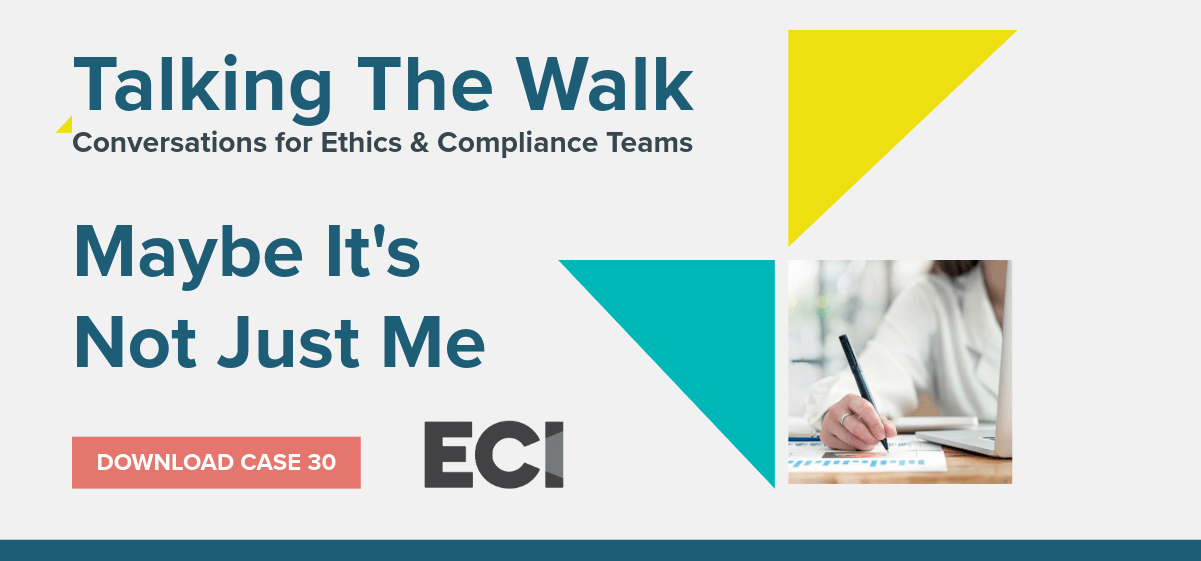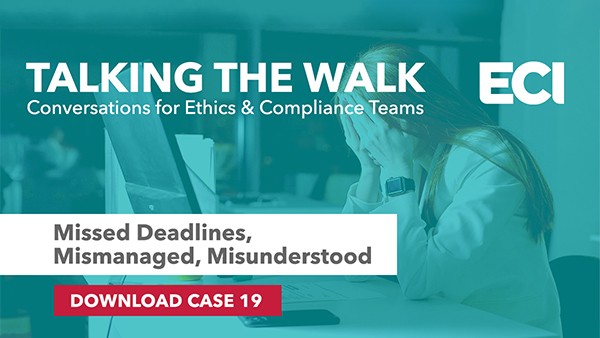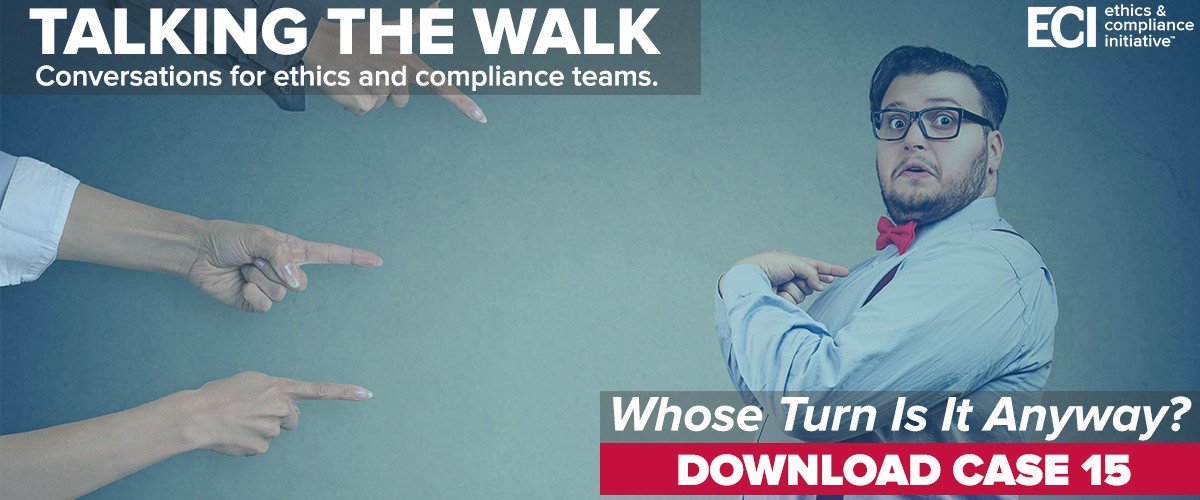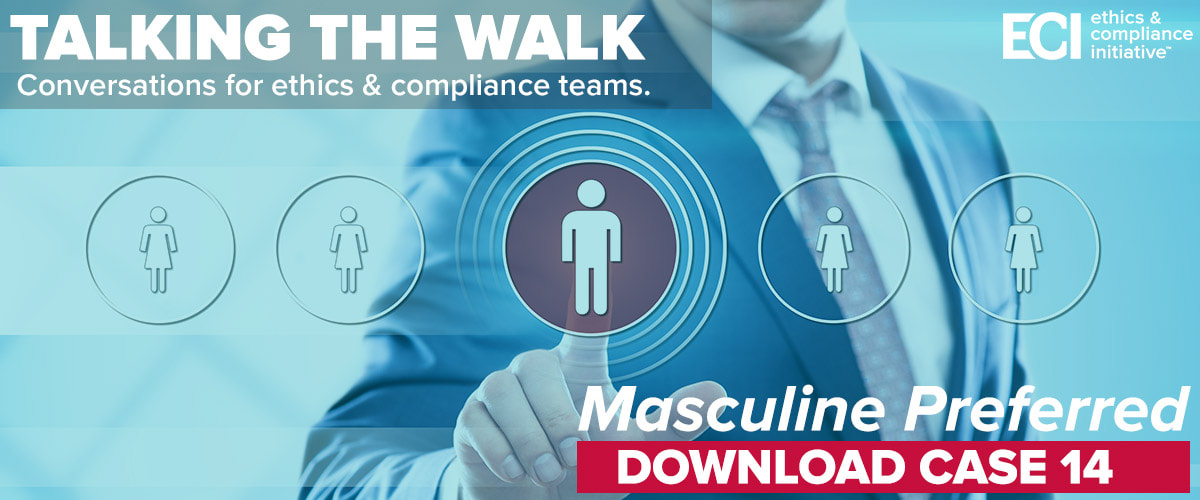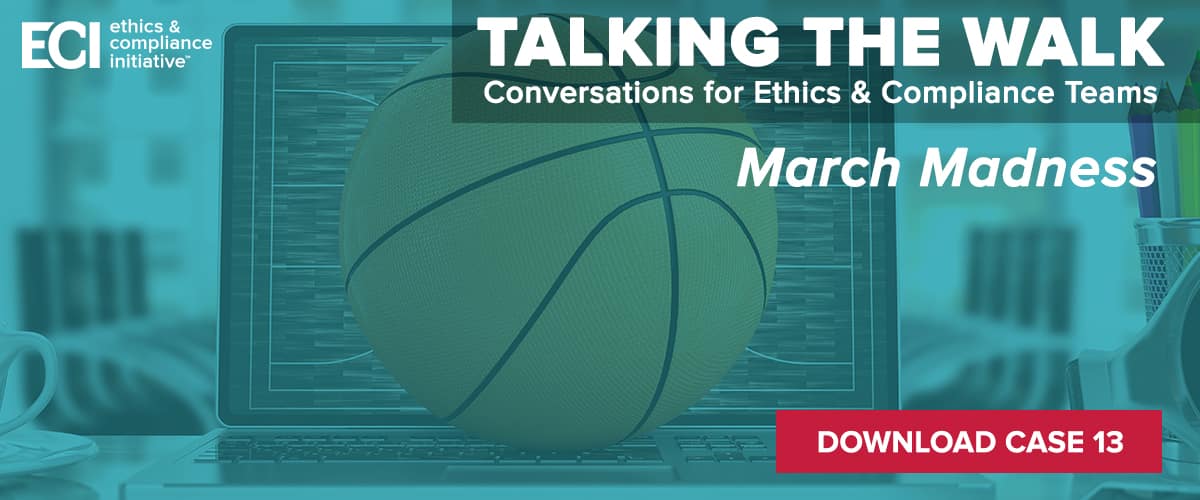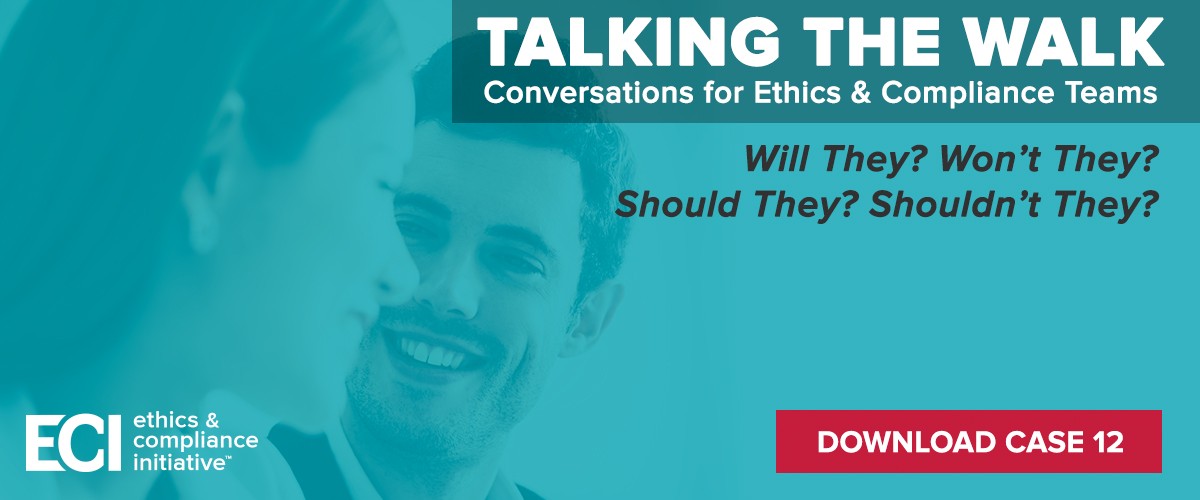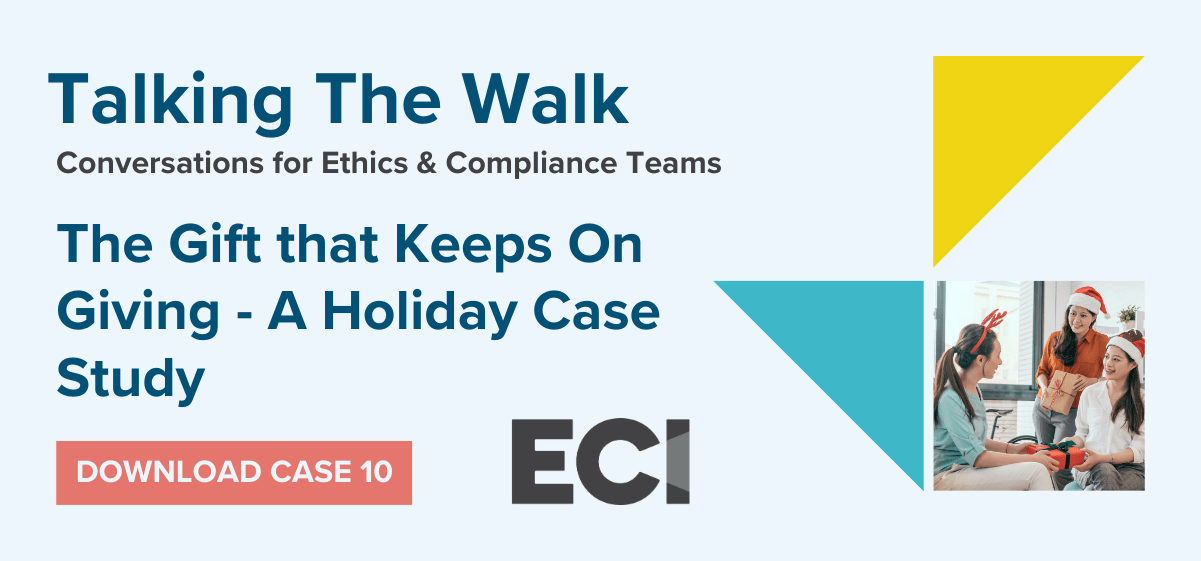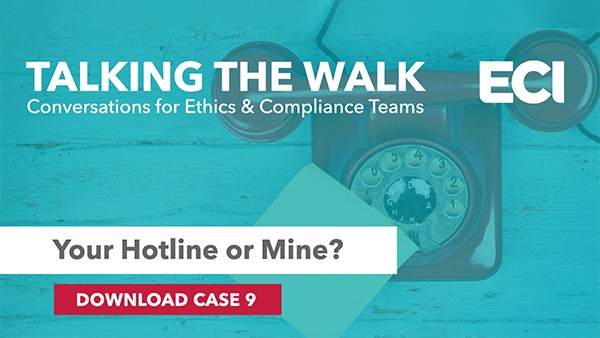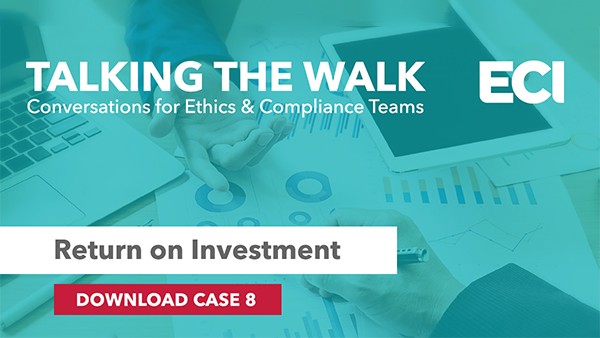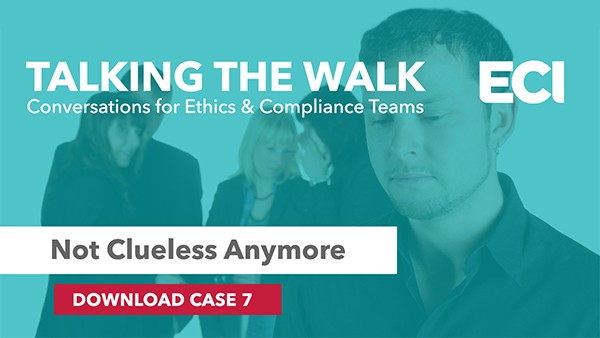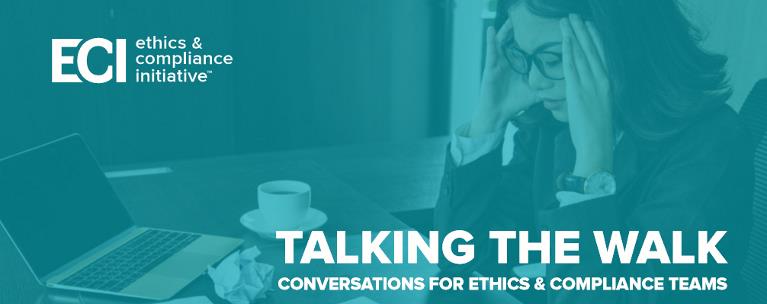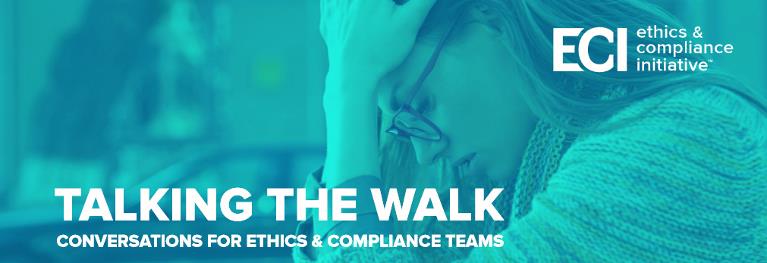At ECI, we work to help others improve their E&C programs.
Organizational and Fellows Members of ECI, are provided a new case study as part of their membership. Each case study is designed to facilitate and help internal compliance teams discuss difficult topics and current risks. The topics pertain to issues in ethics, compliance, leadership, managing up, working as a team and more!
Although almost every ethics and compliance program has its “own way”, ECI has developed some guiding principles that apply to every program. ECI’s case studies are stories designed to help highlight these principles and how to apply them.
These stories are realistic, complex, and filled with contextually rich situations that often involve a dilemma, conflict, or problem that one or more of the characters in the case must negotiate. Because of this complexity, ECI provides a Leader’s Guide specifically designed to help you engage your team and allow them to learn from the case study. Each Leader’s Guide includes questions for discussion and some related statistics from ECI research.
How you use case studies will depend on you, but we hope you will think of these as a regular opportunity for the professional development of your team.
Not an ECI member?
Each case is available to ECI members at any level.
Why Not Become an ECI member?
Whether you are the only E&C person at your company or if there’s a large group of E&C staff, ECI has a membership level that’s perfect for you. Learn more about the different organizational memberships that ECI offers.
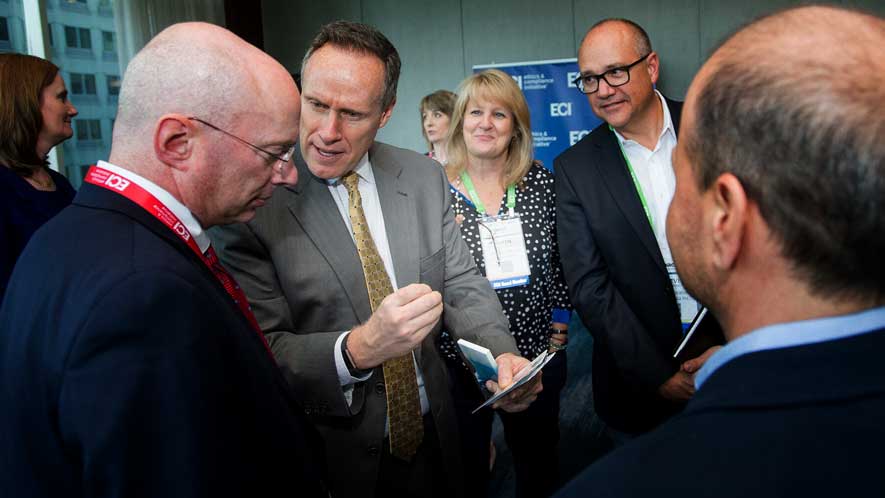
Talking the Walk Ethics Case Studies
Click on the buttons below each case study to be taken to the downloads page for that study. Each page has 3 files:
- Participant Guide – These are for the people who will be participating in the ethics situation.
- Leader’s Guide – This is for the person who will be leading the Talking the Walk session. Inside are instructions detailing how to best use the case study.
- Combined Zip file with both of the above documents.
You can download the files separately, or get them both at one time in the Zip file.
Scroll to the end of the page for a special FREE download that is available to everyone!

Case Study 29: Is It Just Me?
If you see something, say something. It couldn’t be more important, and it seems easy enough. But what if you’re not sure it’s as bad as you think? And if everyone else thinks things are great? And if you don’t want to be a spoilsport? Or a bother? Or a snitch? What if you’re the only one who can’t sleep at night, and the rest of your team is enjoying their sweet dreams? Find out in this month’s Talking the Walk – the first case in a 3-part series!
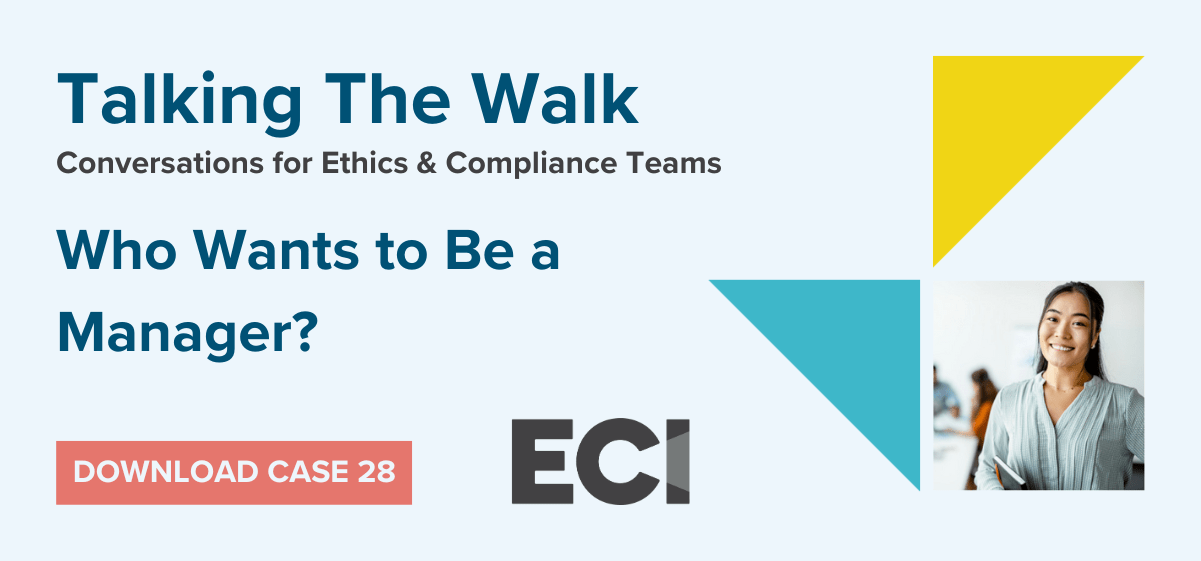
Case Study 28: Who Wants to Be a Manager?
It’s time to hire for a key position. Which will you choose: your boss’s favorite, your team’s up-and-comer, or the trusted ally you worked with in the past? Each has something going for them, and no one agrees on the right pick. You know who you think is best, but can your judgment be trusted? What’s a conflict – and what is just good sense? Find out in this month’s Talking the Walk.

Case Study 27: Balancing Excellence in Quality with Excellence in Timeliness
Being the last set of eyes on a work product should be simple. But sometimes only the last set of eyes can see clearly. What happens when a team has gone too far down the wrong road? How can you get back on track without leaving the team alienated, blindsided, or discouraged? Find out in this month’s Talking the Walk.
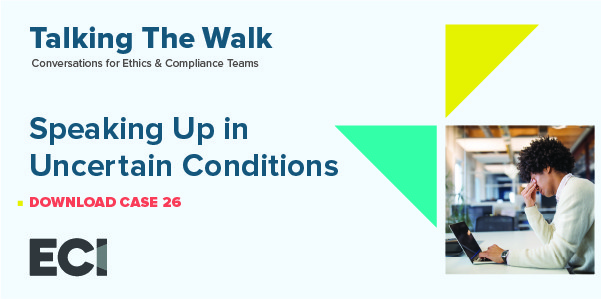
Case Study 26: Speaking Up in Uncertain Conditions
Cut costs. Speed up. Do more. Be more. Better. Faster. Stronger. Cheaper.
What happens when the push to trim the budget and increase efficiency comes for the reporting and investigations team? Just how widespread might the damage be when an organization misses the warning signs of an E&C failure? Find out in this month’s Talking the Walk.
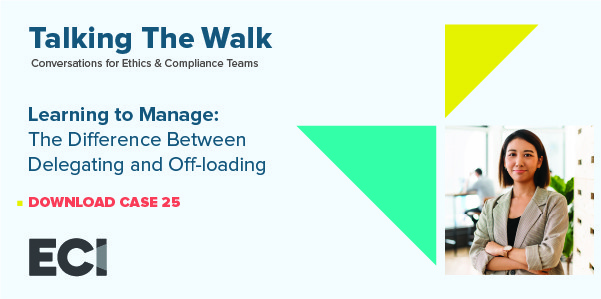
Case Study 25: Learning to Manage: The Difference Between Delegating and Off-loading
Management is a delicate dance—pushing a little, but providing support and giving guidance while empowering your staff to maintain their autonomy. Some managers never give up control and deny their reports the chance to grow and shine. Others throw them into the abyss, issuing assignments and taking credit, but neglecting to provide support or soften blame. Nikky’s internship is a lesson in management gone awry. What lessons will she—will we—walk away with? Find out in this month’s Talking the Walk.
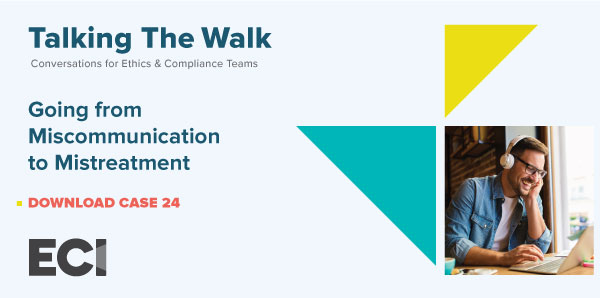
Case Study 24: Going from Miscommunication to Mistreatment
I was just being direct. I was stressed. How was I to know what might upset you? I didn’t mean it that way. There are lots of reasons and lots of excuses. And lots of ways that managers can rationalize away poor treatment and abusive behavior. What does that look like in action? How will it impact your employees and your organization? How can you ensure that your organization lives its values? Find out in this month’s Talking the Walk.
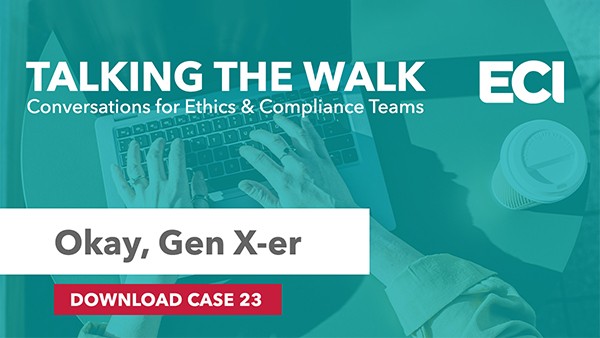
Case Study 23: Okay, Gen X-ER
Workplaces today include employees from four or even five different generations, with different life experiences, sensibilities, and ways of communicating. It can be easy to hurt someone unintentionally, take things the wrong way, or simply talk past each other. How can our team turn conflict into an opportunity for mutual understanding and increased trust? Find out in this month’s Talking the Walk.
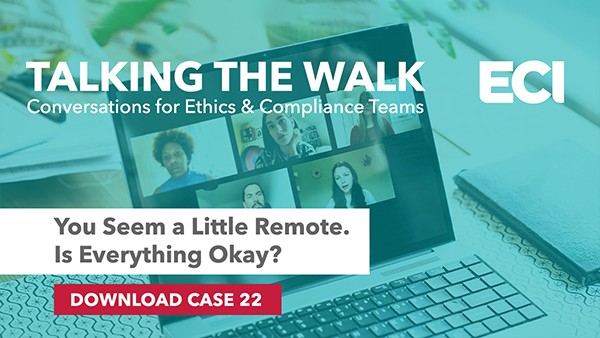
Case Study 22: You Seem a Little Remote. Is Everything Okay?
Don’t get me wrong, I love not having a commute. But I miss the old days when I actually had a work life and a home life. When I could pop by and talk over a concern with a colleague rather than agonizing about how to strike just the right tone over email. When no one could turn off a video conference camera and be on a call without really being “present.” I miss being able to talk about what’s happening in the world without worrying that I’m touching a political hornet’s nest. I wish things could just get back to normal. But I doubt the old normal will ever exist again. How can I, can we, find our way? Find out in this month’s Talking the Walk.

Case Study 21: Put the Meeting Vortex on Your Calendar
You log on, look at your calendar and groan: another day packed with meetings awaits you. More (virtual) face time, even less productivity. You know there has to be a better way, but you can’t solve this alone. Can a meeting about meetings make a difference? Find out in this month’s Talking the Walk.
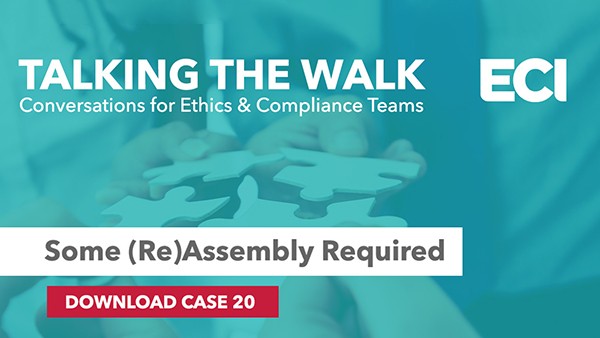
Case Study 20: Some (Re)Assembly Required
You’ve been through a lot as a team. First, the incident. Then, the report and the investigation. Now, you have to face every other day together. How do you adequately acknowledge what you’ve all been through? And how do you move on—together, as a team? Once you’ve made it through a challenging time, how do you find a new normal? Find out in this month’s Talking the Walk.
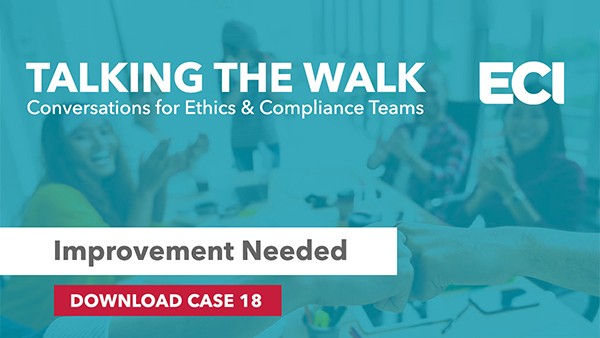
Case Study 18: Improvement Needed

Case Study 17: The Enemy of the Good
The rules matter, but so do values. When employees feel intense pressure to not make mistakes, they can lose sight of the big picture. E&C teams are tasked with encouraging employees to do what’s right, not just avoid doing what’s wrong. How can our team encourage employees to trust themselves and our company’s values?

Case Study 16: A Tale of Two First Days
Feeling left out doesn’t end when you graduate from high school, and being part of a team doesn’t matter only when you’re vying for a state championship. Team dynamics matters, and employees do their best work when they feel included, safe, and valued. How do we welcome new members to our team? And what can we do each day to build a workplace where everyone can thrive?
It’s time to find out in this month’s Talking the Walk case.
Late nights. Weekends. Holidays. Travel. It’s not the most fun, but somebody has to do it; sometimes the job simply has to be done.
How do you decide who has to work when no one wants to?
Will it be the tenured employee counting his days until retirement, the one with an ailing father, the parent of a graduating senior, the new mom whose husband is on the brink, or the singleton who feels like he’s always covering for the rest of the team?
How would you decide? And how will Jesse, the team’s leader?
Find out in this month’s Talking the Walk.
Case studies are released with an included Leader’s Guide, to help you walk employees through the scenario’s, facilitate meaningful conversation and pose questions that lead to important interactions.
Case Study 14: Masculine Preferred
Marie has been hoping and hoping to get ahead, and this looks like it might be her shot. She’s worked for it. She’s poised and ready. But she’s also not the man her potential client is looking to work with. Who gets to decide if she’s right for the job?
Find out in this month’s Talking the Walk.
Case studies are released with an included Leader’s Guide, to help you walk employees through the scenario’s, facilitate meaningful conversation and pose questions that lead to important interactions.
Case Study 13: March Madness
Q: What’s worse than hearing crickets about a project you worked diligently on?
A: Finding out your boss is watching basketball instead of reviewing those documents.
Then again, if can’t beat them, maybe you should join them. What will one young intern choose to do? Find out in this month’s Talking the Walk.
Case Study 12: Will They, Won’t They? Should They, Shouldn’t They?
Elizabeth and Darcy, Sam and Diane, Harry and Sally, Pat and Jim. Countless books, television shows, and movies have revolved around the questions: Will they? Won’t they?
But, in today’s workplace environment, it’s also a matter of Should they? Shouldn’t they?
What decision will one up-and-coming young professional make? And how might it impact everyone around her?
It’s time to think it all through in this month’s Talk the Walk.
Case Study 11: And Today’s Panacea Is…
When it comes to implementing new initiatives, it’s not always easy to know who to involve and how. Sometimes it can feel like new ideas are being rolled out before there’s even time for previous efforts to yield results. But at other companies, any attempt at change gets lost in the muddle of meetings and red tape. How well will one eager CECO strike the balance and what will her team say about her plans?
Think it through. Talk it through. Get ready to Talk the Walk.
Case Study 10: The Gift that Keeps on Giving
The season of giving can turn into the season of extra headaches quickly. Some companies make extra efforts to help employees navigate the quagmire of corporate gift giving; others say little if anything.
In this month’s Talk the Walk, one young employee learns that the forbidden fruit sometimes arrives on your desk in a pretty basket with a plaid bow. What will she do next?
Think it through. Talk it through. Get ready to Talk the Walk.
Case Study 9: Your Hotline or Mine?
How can companies better manage overlapping functions, including helplines? This case outlines a scenario in which departments that work with HR had no overlap with E&C. Want to help employees better understand the unique—but complementary—roles of HR and E&C? Learn more in this month’s Talking the Walk.
Case Study 8: Return on Investment
This case walks though a scenario in which board members are not happy with a recent report from the E&C team, after making a significant investment in E&C to lower claims. How can E&C managers navigate this conversation with board members—and demonstrate the value of their investment? Find out in this month’s Talking the Walk.
Case Study 6: A Bad Day for a Bad Day
Yvonne’s mom is sick, and angry, and takes it out on her. Her E&C team includes old-school employees who “tell it like it is” and younger employees who expect more “consideration.” Something’s gonna give. When will Yvonne boil over? Who will get burned, and how?
Find out how in this month’s Talking the Walk case study.
Case Study 5: Hard Truths and Soft Skills
Productive team meetings distill the insights and expertise of each member, allowing for stronger solutions and more in-depth problem solving.
But sometimes, they don’t.
When a team meeting toes the line between fair critique and unwarranted criticism, it is important that you know exactly how to respond.
Do these coworkers understand what’s at stake? Find out in this month’s Talking the Walk.
Case Study 4: Judgement Call
If they gave frequent flyer miles for helpline calls, Rodney would have earned a trip to Tahiti.
Compliance department team member Dustin knows the type and takes Rodney’s calls in stride.
When Dustin gets a call from someone else with serious (and not conflicting) allegations about Rodney’s boss, he starts to see everything in a new light.
Case Study 3: The Most Wonderful Time of the Year
The holiday season provides a special opportunity for organizations to recognize the contributions of employees and to celebrate hard work and achievements together. But it also brings additional risks and potential headaches.
Find out for yourself in this month’s Talking the Walk.
Case Study 2: Who Cares
Eva’s been waiting for feedback on a major project. CECO Jamal wants to find the time to respond thoughtfully, but never has a moment to spare. Amanda is being squeezed by the needs of her reports, including Eva, and her boss, Jamal.
Find out for yourself in this month’s Talking the Walk.
Case Study 1: Friend or Foe
CEO, Leon, accepted a “friend” request from an employee, and was not prepared for what happened next. Actually “walking the walk” of being an ethical leader in an ethical organization can be a challenge in the real world. So how does one navigate that?
Find out for yourself in this month’s Talking the Walk.
As a leader in your organization, no doubt you have watched the #MeToo and the #TimesUp movements and concluded that we are at a critical juncture in our society.
At the Ethics & Compliance Initiative, we agree. In our view, not only will the current dialogue about sexual misconduct affect the way we relate to each other as individuals; the movement will also have a profound impact on our workplaces.
As the dialogue continues, many of us are asking, “Where do we go from here?”
The answer to this question is not only to focus on what people sometimes do wrong, but also to consider how we can help each other do right. We need to begin a conversation about respect as a core value in our workplaces so that our employees have a shared understanding about how they should treat one another. Respect as a standard also provides a common language to help individuals raise and resolve sensitive concerns.
At ECI we are offering you a FREE special edition case study on workplace sexual misconduct, entitled #RespectAtWork. The case includes questions for discussion that invite employees to talk about their commitment to a respectful workplace. A leader guide is also included, so that every manager can follow instructions and lead the dialogue. It is our hope that you will take this case and distribute it among your employees, then take the time to discuss the scenario together.
We hope you will find this resource to be a helpful way to initiate an important shift in your organization.

